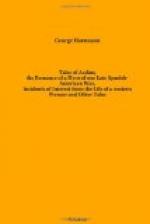AN UNCANNY STONE.
(A sequel to the last chapter of “Wooed by a Sphinx of Astlan."’)
“Gigantic shadows, dancing in the twilight
Fade with the sun’s last golden ray.
On quivering bat-wings, sad and silent,
Flits darkness—night pursuing day.
Hark! as the twelfth hour sounds its knell
At midnight, tolls a whimpering bell
When yawning graves profane their secrecy.
Ghosts stalk in dreamland haunting memory
And spectral visions of departed friends arise
Who freed of sin, that fetter of mortality,
With Angels in their kingdom of Eternal Life
Grace Heaven’s choir of harmony.”
The third day of July A. D. 1907 was a gala-day for the citizens of Prescott, a historic date for Arizona, as then our governor, in behalf of the territory, formally accepted an equestrian statue from its sculptor.
This monument which commemorates our war with Spain had been erected on the public plaza of Prescott in honor of “Roosevelt’s Rough Riders,” the first regiment of United States Volunteer cavalry.
A master-piece of modern art the statue breathes life and action in the perfection of its every detail, representing a Rough Rider who is about to draw his weapon while reining his terrified horse as it rears in a last lunge. This is indicated by the steed’s gaping mouth, distended nostrils, the bent knees, knotted chords and veins of its neck and body.
The expression of a noble beast’s agony is rendered in so life-like a manner that its protruding eyes seem to glaze into the awful stare of death, and instinctively the spectator listens for the stifled whimper and whinnying screams of a wounded creature.
Borglum’s splendid statuary, this heroic cast of bronze which so faithfully portrays the destiny of a dumb animal, man’s most useful and willing slave, always ready to share its master’s fate, even unto death—to my mind is a most eloquent, if silent, argument against all warfare.
But the glory of the monument is its pedestal.
A solid stone, a bed-rock from the cradle of the idol-mountain it was contributed by nature to the memory of one of its noblemen, “Captain William Owen O’Neill,” who crowned his life with immortality, suffering a soldier’s death.
During the storming of San Juan Hill to anxious friends imploring him not recklessly to expose himself, with smiling lips he gave this message of death’s Angel, that mysterious oracle of a Sphinx which from the gaze of mortals veils their ordained doom: “Comrades, sergeant! I thank you for your kindly warning—fear not for me, the Spanish bullet that could kill me is not molded!”—when instantly he fell struck dead—not by a “Spanish” bullet—“no!” but by the bullet fired from a Mauser rifle, “not made in Spain.” Not an ordinary stone this Arizona granite rock is entitled to highest honors among the stones of the earth.




